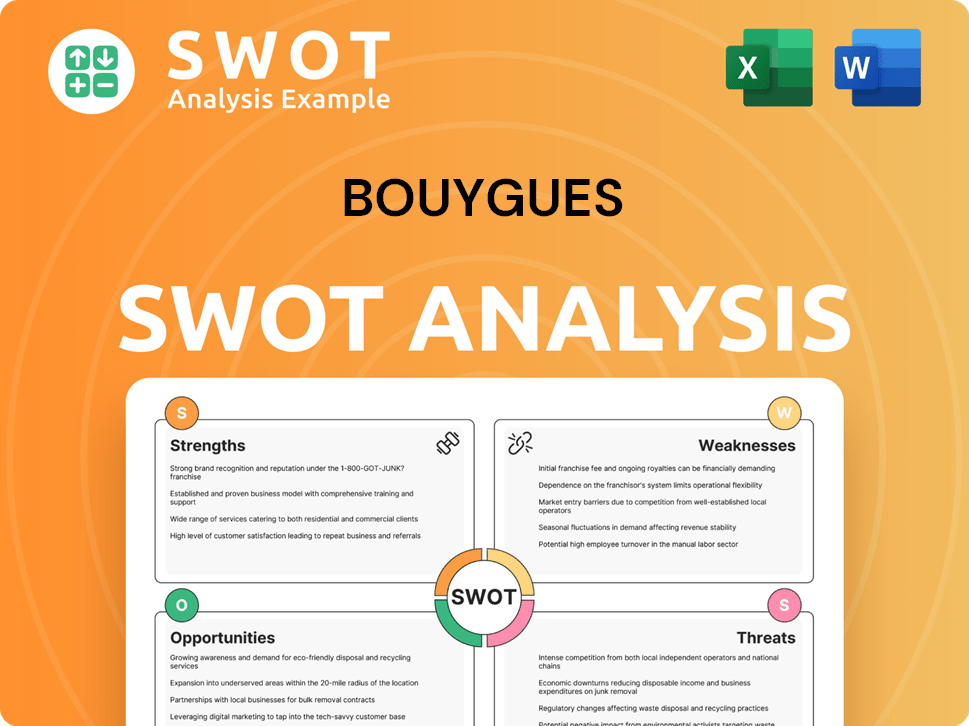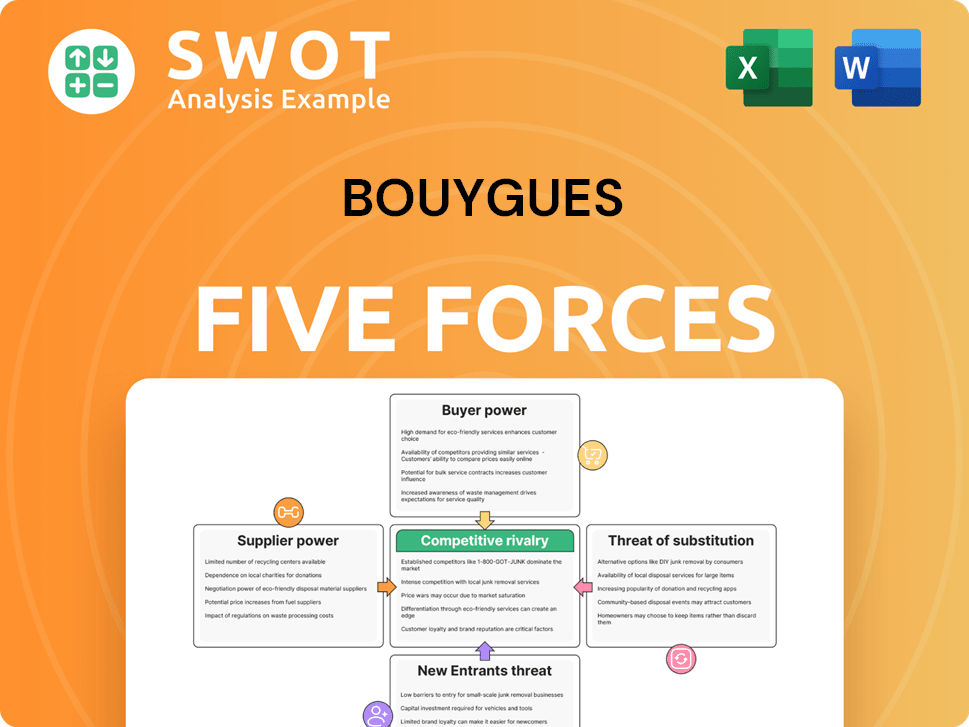Bouygues Bundle
How Does Bouygues Stack Up in Today's Market?
From its humble beginnings in industrial construction, Bouygues has evolved into a global titan, but who are its rivals? This analysis dives deep into the Bouygues SWOT Analysis and competitive arena, scrutinizing its diverse sectors: construction, media, and telecommunications. We'll dissect the Bouygues competitive landscape, revealing the key players and strategic moves shaping its future.

Understanding the Bouygues industry dynamics is crucial for investors and strategists alike. This exploration of Bouygues competitors will provide a comprehensive Bouygues market analysis, evaluating its Bouygues business strategy and Bouygues financial performance against its rivals. By examining its strengths, weaknesses, and strategic positioning, we uncover the factors influencing Bouygues' ability to navigate challenges and capitalize on opportunities in a competitive global market.
Where Does Bouygues’ Stand in the Current Market?
Bouygues maintains a robust market position across its diverse business segments, showcasing a strong competitive landscape. The company's strategic diversification, particularly into telecommunications and media, has enhanced its resilience and growth potential. This diversification has allowed it to capture growth in new, high-potential markets and has provided a hedge against cyclical downturns in the construction industry. Bouygues' financial performance reflects this strength, with total sales reaching €56 billion in 2023.
In construction, Bouygues Construction and Colas hold leading global positions. Bouygues Construction reported €13.6 billion in sales in 2023, while Colas achieved €16.2 billion in sales for the same year, highlighting their significant contributions. Bouygues Telecom is a major player in the French telecommunications market, with a substantial customer base. Furthermore, TF1 Group, a subsidiary, leads in the French private audiovisual sector.
Bouygues' market analysis reveals a strategic shift over time, expanding beyond its construction roots. The company's embrace of digital transformation across its segments further strengthens its operational efficiency and customer experience. Bouygues' strong presence in France and its international reach in construction and roads businesses are key aspects of its competitive positioning. For a deeper dive into how Bouygues approaches its market strategies, consider exploring the Marketing Strategy of Bouygues.
Bouygues Construction and Colas are globally recognized leaders in the construction sector. Bouygues Construction's sales reached €13.6 billion in 2023. Colas, specializing in road construction, reported €16.2 billion in sales during the same period, demonstrating their substantial market share and influence.
Bouygues Telecom is a major player in the French telecommunications market, holding a significant share. As of the end of 2023, Bouygues Telecom had 28.6 million mobile subscribers and 5.1 million fixed subscribers. TF1 Group, a subsidiary, leads in the French private audiovisual sector, enhancing Bouygues' diversified portfolio.
Bouygues' overall financial performance is robust, reflecting its diversified business model. The company's total sales for 2023 reached €56 billion, demonstrating its financial stability. This strong performance is supported by its strategic presence in construction, telecommunications, and media, mitigating risks.
Bouygues has strategically diversified its operations, moving beyond its traditional construction roots. This diversification allows the company to capture growth in new, high-potential markets. It also provides a hedge against cyclical downturns in the construction industry, ensuring sustained growth.
Bouygues Telecom's substantial customer base and significant market share in France highlight its strong competitive position. The company's strategic investments in technology and infrastructure support its growth. This is a key factor in the Bouygues competitive landscape.
- Bouygues Telecom had 28.6 million mobile subscribers as of the end of 2023.
- Bouygues Telecom had 5.1 million fixed subscribers as of the end of 2023.
- TF1 Group holds a significant audience share in television broadcasting.
- Colas reported €16.2 billion in sales for 2023, solidifying its infrastructure dominance.
Bouygues SWOT Analysis
- Complete SWOT Breakdown
- Fully Customizable
- Editable in Excel & Word
- Professional Formatting
- Investor-Ready Format

Who Are the Main Competitors Challenging Bouygues?
The Growth Strategy of Bouygues is significantly influenced by the competitive dynamics within its diverse sectors. Understanding the Bouygues competitive landscape is crucial for assessing its market position and future prospects. This involves a detailed Bouygues market analysis to identify key rivals and evaluate their strategies.
Bouygues competitors vary across construction, telecommunications, and media, each with unique competitive pressures. The company's Bouygues business strategy must address these diverse challenges to maintain and enhance its Bouygues financial performance. This article delves into the key players and competitive dynamics affecting Bouygues.
Bouygues faces a complex competitive environment across its varied operations, requiring strategic adaptability. The company's success hinges on its ability to navigate these competitive pressures effectively.
In the construction and civil works sector, Bouygues' primary rivals include Vinci and Eiffage. These competitors challenge Bouygues through their extensive project portfolios and competitive pricing. The competition is particularly fierce in major public infrastructure projects.
Vinci is a major global player and a direct competitor to Bouygues in building, civil works, and concessions. Vinci's revenue in 2023 was €65.2 billion, significantly larger than Bouygues' construction arm. This scale allows Vinci to bid competitively on large-scale projects worldwide.
Eiffage also poses strong competition in construction and concessions. Eiffage reported 2023 revenue of €21.8 billion. Eiffage competes by leveraging its expertise in various construction segments and its presence in key markets.
In the telecommunications market, Bouygues Telecom competes with Orange, SFR, and Free Mobile in France. These competitors focus on pricing strategies and innovative service offerings to gain market share. The competition for 5G subscribers and fiber optic broadband is a key battleground.
Orange, the former state monopoly, remains the market leader in the French telecom sector. Orange has the largest subscriber base and extensive network infrastructure. Orange's strong position enables it to offer comprehensive services and maintain a significant market share.
SFR and Free Mobile aggressively compete on pricing and innovative service offerings. These companies frequently launch price wars and promotional campaigns to attract subscribers. Their competitive pricing strategies put pressure on Bouygues Telecom's margins.
In the media sector, TF1 Group faces competition from major French broadcasters and digital platforms. Digital platforms are disrupting traditional television viewership. TF1's advertising revenues and audience engagement are challenged by these new competitors.
- TF1 competes with M6 Group (part of RTL Group) and France Télévisions.
- Digital platforms like Netflix, Amazon Prime Video, and YouTube offer on-demand content.
- The proposed merger between TF1 and M6 highlights industry consolidation efforts.
- The rise of streaming services impacts traditional television viewership.
Bouygues PESTLE Analysis
- Covers All 6 PESTLE Categories
- No Research Needed – Save Hours of Work
- Built by Experts, Trusted by Consultants
- Instant Download, Ready to Use
- 100% Editable, Fully Customizable

What Gives Bouygues a Competitive Edge Over Its Rivals?
The competitive landscape of Bouygues is shaped by its diversified business model, encompassing construction, telecom, and media. Bouygues's strategic moves and financial performance are closely watched in the industry. A deep dive into Bouygues's key competitors helps to understand its market position.
Bouygues has demonstrated resilience and adaptability in a dynamic market. Its ability to maintain a strong market share and navigate economic cycles is a key focus. This analysis explores the competitive advantages that enable Bouygues to thrive in its various sectors and how it differentiates itself from its rivals.
Understanding Bouygues's competitive advantages is crucial for investors, analysts, and business strategists. This analysis provides insight into the company's strengths, weaknesses, opportunities, and threats. For a comprehensive view of the company, consider exploring the Target Market of Bouygues.
Bouygues's integrated business model is a significant advantage. The synergies between construction, telecom, and media divisions create cross-selling opportunities. For instance, Bouygues Construction can leverage Bouygues Telecom's digital infrastructure capabilities.
The company benefits from strong brand equity, especially in France. This fosters customer loyalty and trust, which is vital in consumer-facing telecom and media, as well as in large-scale construction projects. This brand recognition supports market share and customer retention.
Bouygues has extensive experience in complex and large-scale projects. This includes public-private partnerships, which give it a competitive edge. Its robust R&D in sustainable construction and smart city solutions positions it well for future industry trends. This expertise is critical for winning major contracts.
Bouygues Telecom boasts a high-quality network, consistently ranking well in coverage and speed. This is crucial for customer acquisition and retention. Customer-centric approaches and competitive service offerings also contribute to its strong market position.
Bouygues continually adapts to market demands, with a focus on digital transformation and sustainable solutions. While brand recognition and economies of scale are sustainable, technological leadership in telecom requires continuous investment. The company's strategic focus includes expanding its digital services and investing in green technologies to maintain its competitive edge.
- Digital Transformation: Bouygues is investing heavily in digital technologies across all segments.
- Sustainable Solutions: The company is increasing its focus on environmentally friendly practices in construction and telecom.
- Market Expansion: Bouygues is exploring opportunities for growth in new markets and services.
- Financial Performance: In 2024, Bouygues reported revenues of €46.8 billion, demonstrating its financial strength.
Bouygues Business Model Canvas
- Complete 9-Block Business Model Canvas
- Effortlessly Communicate Your Business Strategy
- Investor-Ready BMC Format
- 100% Editable and Customizable
- Clear and Structured Layout

What Industry Trends Are Reshaping Bouygues’s Competitive Landscape?
The competitive landscape for Bouygues reflects a diverse set of industries, each with unique dynamics. Bouygues' industry position is shaped by its presence in construction, telecommunications, and media, facing both established rivals and emerging disruptors. The company's future outlook hinges on its ability to navigate industry trends, mitigate risks, and capitalize on opportunities for growth and innovation. A comprehensive Bouygues market analysis reveals the importance of understanding its competitive environment.
Risks include fluctuating raw material prices, intense competition in telecommunications, and the ongoing shift to digital content in media. However, the company is well-positioned to leverage its diversified portfolio and strategic initiatives to maintain its competitive edge. The future outlook for Bouygues depends on its ability to adapt to changing market conditions, invest in innovation, and foster strategic partnerships. Understanding the Bouygues competitive landscape is key to assess its potential.
In construction, the trend towards sustainable infrastructure and smart cities is prominent. Telecommunications sees the continued rollout of 5G and fiber-to-the-home (FTTH) networks as key drivers. The media sector is undergoing a shift to digital content and on-demand services. These trends influence Bouygues' business strategy across its various segments.
Challenges include volatility in raw material prices and labor shortages in construction. The telecommunications sector faces intense competition and the need for significant capital expenditure. In media, the shift to digital content and competition from global streaming giants poses a challenge. These factors impact Bouygues' financial performance.
Opportunities exist in sustainable infrastructure and smart city projects for Bouygues Construction. Bouygues Telecom can capitalize on 5G and fiber expansion. TF1 can explore targeted advertising and digital service development. These opportunities can boost Bouygues' market share in France.
Bouygues is focusing on innovation, operational efficiency, and strategic acquisitions to strengthen its market position. This includes investments in digital platforms, content creation, and sustainable construction methods. Strategic partnerships and alliances are also important for growth.
In construction, Bouygues faces competition from Vinci and Eiffage, focusing on sustainable projects and smart city solutions. In telecommunications, key rivals include Orange and SFR, with 5G and fiber rollout being major battlegrounds. TF1 competes with global streaming services and other broadcasters in the media sector. Recent acquisitions and mergers have reshaped the competitive landscape.
- Construction: Focus on sustainable building practices and infrastructure projects.
- Telecommunications: Expansion of 5G networks and fiber optic infrastructure.
- Media: Investment in digital platforms and original content.
- Financial Performance: Adapting to economic conditions to maintain profitability.
Bouygues Porter's Five Forces Analysis
- Covers All 5 Competitive Forces in Detail
- Structured for Consultants, Students, and Founders
- 100% Editable in Microsoft Word & Excel
- Instant Digital Download – Use Immediately
- Compatible with Mac & PC – Fully Unlocked

Related Blogs
- What are Mission Vision & Core Values of Bouygues Company?
- What is Growth Strategy and Future Prospects of Bouygues Company?
- How Does Bouygues Company Work?
- What is Sales and Marketing Strategy of Bouygues Company?
- What is Brief History of Bouygues Company?
- Who Owns Bouygues Company?
- What is Customer Demographics and Target Market of Bouygues Company?
Disclaimer
All information, articles, and product details provided on this website are for general informational and educational purposes only. We do not claim any ownership over, nor do we intend to infringe upon, any trademarks, copyrights, logos, brand names, or other intellectual property mentioned or depicted on this site. Such intellectual property remains the property of its respective owners, and any references here are made solely for identification or informational purposes, without implying any affiliation, endorsement, or partnership.
We make no representations or warranties, express or implied, regarding the accuracy, completeness, or suitability of any content or products presented. Nothing on this website should be construed as legal, tax, investment, financial, medical, or other professional advice. In addition, no part of this site—including articles or product references—constitutes a solicitation, recommendation, endorsement, advertisement, or offer to buy or sell any securities, franchises, or other financial instruments, particularly in jurisdictions where such activity would be unlawful.
All content is of a general nature and may not address the specific circumstances of any individual or entity. It is not a substitute for professional advice or services. Any actions you take based on the information provided here are strictly at your own risk. You accept full responsibility for any decisions or outcomes arising from your use of this website and agree to release us from any liability in connection with your use of, or reliance upon, the content or products found herein.